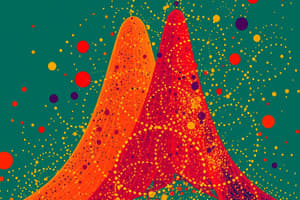Podcast
Questions and Answers
What does the sample space represent in a random experiment?
What does the sample space represent in a random experiment?
- All possible outcomes (correct)
- The likelihood of the outcome
- The specific event
- The total number of events
In probability calculations, what is the formula used?
In probability calculations, what is the formula used?
- Sum of favorable events
- Number of favorable events / Total number of events (correct)
- Average of favorable events
- Total number of events / Number of favorable events
What does a random variable represent?
What does a random variable represent?
- A function from the sample space to real numbers (correct)
- The likelihood of an outcome occurring
- The total number of events in the sample space
- A specific event in the sample space
Which type of random variable involves measuring weight?
Which type of random variable involves measuring weight?
What does a probability distribution table provide?
What does a probability distribution table provide?
Why are coin tossing and card selection examples used to explain random experiments?
Why are coin tossing and card selection examples used to explain random experiments?
Flashcards are hidden until you start studying
Study Notes
- The text discusses probability distributions, random processes, and numerical methods in a paper titled "A Probability Distribution, Random Process, and Numerical Methods."
- It mentions the concept of a random experiment where the outcome cannot be predicted beforehand, giving examples like coin tossing and card selection.
- In a random experiment, the sample space represents all possible outcomes, and the result of the experiment is a specific event within that sample space.
- The text emphasizes that in a random experiment, the outcome cannot be predetermined, highlighting the unpredictable nature of certain experiments.
- It also touches on the idea that the sample space is a fundamental concept in understanding random experiments, representing all possible outcomes and events.- Tynan discusses random experiments involving events like tossing coins and their probabilities.
- Probability is calculated by dividing the number of favorable events by the total number of events in the sample space.
- A random variable is a function from the sample space to the set of real numbers, denoted by a capital letter like X.
- In a coin-tossing example, the random variable X represents the number of heads, with corresponding probabilities for each outcome.
- The values of X and their corresponding probabilities form a probability distribution table.
- There are two types of random variables: discrete (like coin tosses) and continuous (like measuring weight).
- For continuous random variables, probability is distributed over intervals rather than specific values.
- The text covers topics like probability distributions, functions of random variables, and sequences and series in mathematics.
Studying That Suits You
Use AI to generate personalized quizzes and flashcards to suit your learning preferences.




